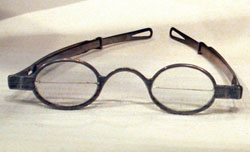Benjamin Franklin Bifocals
|
| updated |
Copy Link Code
|
 As Benjamin Franklin aged, his vision, which had never been great, deteriorated even further. Like many of the instances in his life when an ongoing challenge presented itself, Franklin devised an invention that would help him to see long distances and be able to continue his favorite hobby, reading. For Ben Franklin, spectacles were not enough; he described his invention as "double-spectacles." The new version of Ben Franklin eyeglasses would come to be known as bifocals. The process of their invention was quite simple. In 1784, Franklin wrote to his optician and made a request: take both his long distance glasses and his reading glasses, slice their lenses in half and then suture the lenses together with the reading lenses on the bottom and the long distance glasses on the top. Franklin would be able to avoid the hassle of switching glasses while he moved between reading and walking about. There is further evidence from other Founding Fathers that Franklin had fashioned his own pair of these "double spectacles" decades before.
As Benjamin Franklin aged, his vision, which had never been great, deteriorated even further. Like many of the instances in his life when an ongoing challenge presented itself, Franklin devised an invention that would help him to see long distances and be able to continue his favorite hobby, reading. For Ben Franklin, spectacles were not enough; he described his invention as "double-spectacles." The new version of Ben Franklin eyeglasses would come to be known as bifocals. The process of their invention was quite simple. In 1784, Franklin wrote to his optician and made a request: take both his long distance glasses and his reading glasses, slice their lenses in half and then suture the lenses together with the reading lenses on the bottom and the long distance glasses on the top. Franklin would be able to avoid the hassle of switching glasses while he moved between reading and walking about. There is further evidence from other Founding Fathers that Franklin had fashioned his own pair of these "double spectacles" decades before.
The first mention of the concept of glasses with a split frame composed of lenses with varying power was in 1683, but the inventor behind them never moved his invention to market and was mostly forgotten. In Franklin's own time, he was credited with their invention although others soon took out patents on the same concept. As in the case of his iron stove, Franklin was not interested in profiting from his invention as much as sharing it with friends and the community so that others might have a more enjoyable and productive life. On bifocals, Benjamin Franklin assured his vision-impaired friends that they would enjoy and possibly extend the later years of their life with such eyeglasses. Two decades after Franklin's death, Thomas Jefferson requested a pair of bifocals to be crafted for his use and described them as an invention of Dr. Franklin. After wearing them for a time, Jefferson reported to his hyperopic friend that he had "adopted Dr. Franklin's plan of half glasses of different focal distances, with great advantage." Like the lightning rod, the odometer and the Pennsylvania stove, Ben Franklin glasses were an invention that helped both himself and many of his friends and compatriots.
Since the time of Benjamin Franklin's spectacular development, billions of individuals have improved their lives through the use of bifocals. Like Franklin, many avid readers succumb to hyperopia and myopia long before they lose an interest in books and knowledge. Without the invention of bifocals, many of the vision-impaired would depend on multiple pairs of glasses or the uncomfortable alternative of glasses on top of glasses. Benjamin Franklin's bifocals led a wave of evolution that has peaked with modern day glasses that have three or more varying degrees of convex glass all within one lens. Franklin often developed inventions purely for convenience, such as the extension arm with a grabber on the end; however, we can not downplay the value of convenience. By solving an inconvenience, Franklin has allowed billions of people to lead happier, fuller lives even as their vision fades with time.
